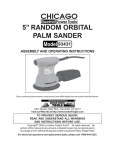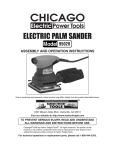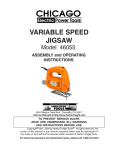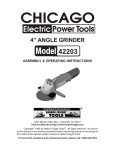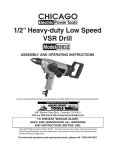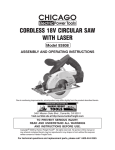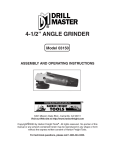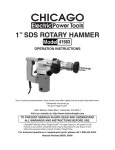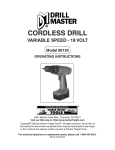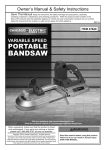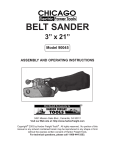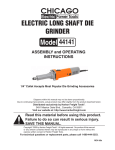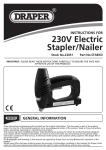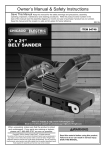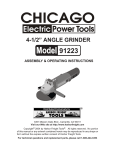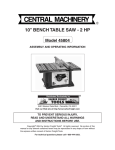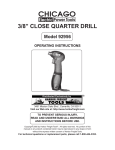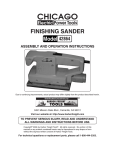Download Harbor Freight Tools 91494 User's Manual
Transcript
ELECTRIC NAILER / STAPLER MODEL 91494 ASSEMBLY AND OPERATING INSTRUCTIONS 3491 Mission Oaks Blvd., Camarillo, CA 93011 Visit our Web site at http://www.harborfreight.com TO PREVENT SERIOUS INJURY, READ AND UNDERSTAND ALL WARNINGS AND INSTRUCTIONS BEFORE USE. Copyright© 2004 by Harbor Freight Tools®. All rights reserved. No portion of this manual or any artwork contained herein may be reproduced in any shape or form without the express written consent of Harbor Freight Tools. For technical questions and replacement parts, please call 1-800-444-3353 PRODUCT SPECIFICATIONS Motor 120 Volts, 60 Hz Magazine Capacity 100 Brad Nails or Staples Staple Capacity .0253” (Approx. 22 Gauge), 3/8” Crown, 1/4”-5/8” L Brad Nail Capacity .0403” (Approx. 18 Gauge), 3/8”-5/8” L Overall Dimensions 10” x 8” x 2-1/2” Firing Speed 30 Brad Nails or Staples per minute (Max.) E194601 Accessories: Staples - 500 @ 1/4” L, 500 @ 1/2” L, 500 @ 5/8” L; Brad Nails - 500 @ 3/8” L, 500 @ 5/8” L, Safety Goggles, Case, Wrench (2) SAVE THIS MANUAL You will need this manual for the safety warnings and precautions, assembly, operating, inspection, maintenance and cleaning procedures, parts list and assembly diagram. Keep your invoice with this manual. Write the invoice number on the inside of the front cover. Keep this manual and invoice in a safe and dry place for future reference. GENERAL SAFETY RULES WARNING! READ AND UNDERSTAND ALL INSTRUCTIONS Failure to follow all instructions listed below may result in electric shock, fire, and/or serious injury. SAVE THESE INSTRUCTIONS WORK AREA 1. Keep your work area clean and well lit. Cluttered benches and dark areas invite accidents. Make sure there is adequate surrounding workspace. Always keep the work area free of obstructions, grease, oil, trash, and other debris. 2. Do not operate power tools in explosive atmospheres, such as in the presence of flammable liquids, gases, or dust. Power tools create sparks which may ignite the dust or fumes. 3. Keep bystanders, children, and visitors away while operating a power tool. Distractions can cause you to lose control. Protect others in the work area from debris such as chips and sparks. Provide barriers or shields as needed. SKU 91494 For technical questions, please call 1-800-444-3353. Page 2 ELECTRICAL SAFETY 4. Grounded tools must be plugged into an outlet properly installed and grounded in accordance with all codes and ordinances. Never remove the grounding prong or modify the plug in any way. Do not use any adapter plugs. Check with a qualified electrician if you are in doubt as to whether the outlet is properly grounded. If the tools should electrically malfunction or break down, grounding provides a low resistance path to carry electricity away from the user. 5. Double insulated tools are equipped with a polarized plug (one blade is wider than the other). This plug will fit in a polarized outlet only one way. If the plug does not fit fully in the outlet, reverse the plug. If it still does not fit, contact a qualified electrician to install a polarized outlet. Do not change the plug in any way. Double insulation eliminates the need for the three wire grounded power cord and grounded power supply system. 6. Avoid body contact with grounded surfaces such as pipes, radiators, ranges, and refrigerators. There is an increased risk of electric shock if your body is grounded. 7. Do not expose power tools to rain or wet conditions. Water entering a power tool will increase the risk of electric shock. 8. Do not abuse the Power Cord. Never use the Power Cord to carry the tools or pull the Plug from an outlet. Keep the Power Cord away from heat, oil, sharp edges, or moving parts. Replace damaged Power Cords immediately. Damaged Power Cords increase the risk of electric shock. 9. When operating a power tool outside, use an outdoor extension cord marked “W-A” or “W”. These extension cords are rated for outdoor use, and reduce the risk of electric shock. PERSONAL SAFETY 10. Stay alert. Watch what you are doing, and use common sense when operating a power tool. Do not use a power tool while tired or under the influence of drugs, alcohol, or medication. A moment of inattention while operating power tools may result in serious personal injury. 11. Dress properly. Do not wear loose clothing or jewelry. Contain long hair. Keep your hair, clothing, and gloves away from moving parts. Loose clothes, jewelry, or long hair can be caught in moving parts. SKU 91494 For technical questions, please call 1-800-444-3353. Page 3 12. Avoid accidental starting. Be sure the Trigger is released before plugging in. Carrying power tools with your finger on the Trigger, or plugging in power tools with the Trigger on, invites accidents. 13. Remove adjusting keys or wrenches before plugging the tool in. A wrench or a key that is left attached to a moving part of the power tool may result in personal injury. 14. Do not overreach. Keep proper footing and balance at all times. Proper footing and balance enables better control of the power tool in unexpected situations. 15. Use safety equipment. Always wear eye protection. Dust mask, nonskid safety shoes, hard hat, or hearing protection must be used for appropriate conditions. Always wear work gloves and the included ANSI approved safety goggles. TOOL USE AND CARE 16. Use clamps (not included) or other practical ways to secure and support the workpiece to a stable platform. Holding the work by hand or against your body is unstable and may lead to loss of control. 17. Do not force the tool. Use the correct tool for your application. The correct tool will do the job better and safer at the rate for which it is designed. 18. Do not use tool if switch does not turn it on or off. Any tool that cannot be controlled with the switch is dangerous and must be repaired. Any tool that cannot be controlled with the Trigger is dangerous and must be repaired or replaced. 19. Disconnect the Power Cord Plug from the power source before making any adjustments, changing accessories, or storing the tool. Such preventive safety measures reduce the risk of starting the tool accidentally. 20. Store idle tools out of reach of children and other untrained persons. Tools are dangerous in the hands of untrained users. 21. Maintain tools with care. Keep tools clean. Properly maintained tools are less likely to bind and are easier to control. Do not use a damaged tool. Tag damaged tools “Do not use” until repaired. 22. Check for misalignment or binding of moving parts, breakage of parts, and any other condition that may affect the tool’s operation. If damaged, have the tool serviced before using. Many accidents are caused by poorly maintained tools. REV 07/04 SKU 91494 For technical questions, please call 1-800-444-3353. Page 4 23. Use only accessories that are recommended by the manufacturer for your model. Accessories that may be suitable for one tool may become hazardous when used on another tool. SERVICE 24. Tool service must be performed only by qualified repair personnel. Service or maintenance performed by unqualified personnel could result in a risk of injury. 25. When servicing a tool, use only identical replacement parts. Follow instructions in the “Inspection, Maintenance, And Cleaning” section of this manual. Use of unauthorized parts or failure to follow maintenance instructions may create a risk of electric shock or injury. SPECIFIC SAFETY RULES 1. Hold tool by insulated gripping surfaces when performing an operation where the cutting tool may contact hidden wiring or its own cord. Contact with a “live” wire will make exposed metal parts of the tool “live” and shock the operator. 2. Maintain labels and nameplates on the Nailer / Stapler. These carry important information. If unreadable or missing, contact Harbor Freight Tools for a replacement. 3. Avoid unintentional starting. Make sure you are prepared to begin work before turning on the Nailer / Stapler. 4. Do not force the Nailer / Stapler. This tool will do the work better and safer at the speed and capacity for which it was designed. 5. Never leave the Nailer / Stapler unattended when it is plugged into an electrical outlet. Turn off the tool, and unplug it from its electrical outlet before leaving. 6. Always keep your hands away from the workpiece when firing Brad Nails and Staples. This Nailer / Stapler has enough power to force Brad Nails or Staples through skin, causing serious injury. REV 07/04 SKU 91494 For technical questions, please call 1-800-444-3353. Page 5 7. Always unplug the Nailer / Stapler from its electrical outlet before performing and inspection, maintenance, or cleaning procedures. 8. Do not load Brad Nails or Staples with the trigger or safety depressed or when plugged into the power outlet. Unintentional firing may occur. 9. Fire fasteners into an appropriate work surface only. Do not attempt to fire fasteners into surfaces too hard to penetrate. Do not drive fasteners on top of other fasteners, or at too steep of an angle. Fasteners can ricochet causing personal injury. 10. Do not fire fasteners too close to the edge of a workpiece. They may split the workpiece and fly free, causing personal injury. 11. WARNING! Some dust created by power sanding, sawing, grinding, drilling, and other construction activities, contain chemicals known (to the State of California) to cause cancer, birth defects or other reproductive harm. Some examples of these chemicals are: lead from lead-based paints, crystalline silica from bricks and cement or other masonry products, arsenic and chromium from chemically treated lumber. Your risk from these exposures varies, depending on how often you do this type of work. To reduce your exposure to these chemicals: work in a well ventilated area, and work with approved safety equipment, such as those dust masks that are specially designed to filter out microscopic particles. (California Health & Safety Code 25249.5, et seq.) 12. WARNING! People with pacemakers should consult their physician(s) before using this product. Electromagnetic fields in close proximity to a heart pacemaker could cause interference to or failure of the pacemaker. In addition, people with pacemakers should adhere to the following: - Avoid operating power tools alone. - Don’t use a power tool with the power switch locked on. - If powered via a power cord be certain that the tool is properly grounded. A ground fault interrupt (GFCI) system is also a good precaution. This inexpensive device is a good safety measure because it prevents a sustained electrical shock. - Properly maintain and inspect all tools before use to avoid electrical shock. SKU 91494 For technical questions, please call 1-800-444-3353. Page 6 GROUNDING WARNING! Improperly connecting the grounding wire can result in the risk of electric shock. Check with a qualified electrician if you are in doubt as to whether the outlet is properly grounded. Do not modify the power cord plug provided with the tool. Never remove the grounding prong from the plug. Do not use the tool if the power cord or plug is damaged. If damaged, have it repaired by a service facility before use. If the plug will not fit the outlet, have a proper outlet installed by a qualified electrician. GROUNDED TOOLS: TOOLS WITH THREE PRONG PLUGS 1. Tools marked with “Grounding Required” have a three wire cord and three prong grounding plug. The plug must be connected to a properly grounded outlet. If the tool should electrically malfunction or break down, grounding provides a low resistance path to carry electricity away from the user, reducing the risk of electric shock. (See Figure A.) 2. The grounding prong in the plug is connected through the green wire inside the cord to the grounding system in the tool. The green wire in the cord must be the only wire connected to the tool’s grounding system and must never be attached to an electrically “live” terminal. (See Figure A.) 3. Your tool must be plugged into an appropriate outlet, properly installed and grounded in accordance with all codes and ordinances. The plug and outlet should look like those in the following illustration. (See Figure A.) FIGURE A SKU 91494 For technical questions, please call 1-800-444-3353. Page 7 DOUBLE INSULATED TOOLS: TOOLS WITH TWO PRONG PLUGS 4. Tools marked “Double Insulated” do not require grounding. They have a special double insulation system which satisfies OSHA requirements and complies with the applicable standards of Underwriters Laboratories, Inc., the Canadian Standard Association, and the National Electrical Code. (See Figure B.) 5. Double insulated tools may be used in either of the 120 volt outlets shown in the following illustration. (See Figure B.) FIGURE B EXTENSION CORDS 1. Grounded tools require a three wire extension cord. Double Insulated tools can use either a two or three wire extension cord. 2. As the distance from the supply outlet increases, you must use a heavier gauge extension cord. Using extension cords with inadequately sized wire causes a serious drop in voltage, resulting in loss of power and possible tool damage. (See Figure C, next page.) 3. The smaller the gauge number of the wire, the greater the capacity of the cord. For example, a 14 gauge cord can carry a higher current than a 16 gauge cord. (See Figure C.) 4. When using more than one extension cord to make up the total length, make sure each cord contains at least the minimum wire size required. (See Figure C.) 5. If you are using one extension cord for more than one tool, add the nameplate amperes and use the sum to determine the required minimum cord size. (See Figure C.) SKU 91494 For technical questions, please call 1-800-444-3353. Page 8 6. If you are using an extension cord outdoors, make sure it is marked with the suffix “W-A” (“W” in Canada) to indicate it is acceptable for outdoor use. 7. Make sure your extension cord is properly wired and in good electrical condition. Always replace a damaged extension cord or have it repaired by a qualified electrician before using it. 8. Protect your extension cords from sharp objects, excessive heat, and damp or wet areas. RECOMMENDED MINIMUM WIRE GAUGE FOR EXTENSION CORDS* (120 VOLT) NAMEPLATE AMPERES (At Full Load) EXTENSION CORD LENGTH 25 FEET 0 - 2.0 2.1 - 3.4 3.5 - 5.0 5.1 - 7.0 7.1 - 12.0 12.1 - 16.0 16.1 - 20.0 FIGURE C 50 FEET 75 FEET 100 FEET 150 FEET 18 18 18 16 14 12 10 16 16 16 14 12 10 - 16 14 14 12 10 - 16 14 12 12 - 18 18 18 18 18 14 12 *Based on limiting the line voltage drop to five volts at 150% of the rated amperes. SYMBOLOGY Double Insulated Canadian Standards Association Underwriters Laboratories, Inc. V~ A no xxxx/min. SKU 91494 Volts Alternating Current Amperes No Load Revolutions per Minute (RPM) For technical questions, please call 1-800-444-3353. Page 9 UNPACKING When unpacking, check to make sure all the parts shown on the Parts List on page 13 are included. If any parts are missing or broken, please call Harbor Freight Tools at the number shown on the cover of this manual as soon as possible. ASSEMBLY AND OPERATING INSTRUCTIONS NOTE: For additional information regarding the parts listed in the following pages, refer to the Assembly Diagram on page 14. Apply Pressure Here FIGURE 1 Power Cord (7) Trigger (13) Lever (29) Fastener Window Nose (19) Magazine (22) Safety (21) Warning: This Nailer / Stapler is not suited for nailing or stapling into concrete, masonry, bricks, or metal. Warning! Do not fire if Brad Nails or Staples are jammed in the Nose (19) section. Unplug the unit and follow the “Removing Jammed Staples or Brad Nails” on page 12. SKU 91494 For technical questions, please call 1-800-444-3353. Page 10 ASSEMBLY AND OPERATING INSTRUCTIONS (cont.) Warning! This Nailer has a Sequential Trip safety mechanism. With the nose of the Nailer contacting a surface, the unit will fire only once when the trigger is pulled. Testing the Sequential Trip Safety Mechanism 1. The Nailer should not fire if the Safety (21) is not depressed against the workpiece. 2. Make sure the tool is disconnected from the power supply. 3. Empty the Magazine (22) of nails. 4. Check that the Trigger (13) and the Safety (21) of the tool, move freely, without sticking. 5. Plug the tool into the power outlet. 6. Test the tool by depressing the Safety (21) of the tool against the workpiece without pulling the Trigger (13). The tool must not cycle (fire). If it cycles (fires), stop immediately and take the tool to an qualified service technician for repair. 7. Hold the tool away or off of the workpiece. The Safety (21) of the tool should return to its original position. Squeeze the Trigger (13). The tool should not cycle (fire). If it cycles (fires), stop immediately and take the tool to an authorized service technician. 8. Depress the Safety (21) of the tool against the workpiece and squeeze the Trigger (13). The tool must cycle (fire) once only. If it fails to cycle (fire) or fires more than once, take it to an authorized service technician. Warning! Disconnect the Nailer from the power outlet whenever loading it. Loading Brad Nails and Staples - See FIGURES 2 and 3 below. 1. Depress the Lever (29) and extend the Inner Magazine (24) all the way out . 2. When loading Brad Nails, make sure you insert the pins of the nails on the side of the Magazine (22) with the groove in it. The Brad Nails should fit into the groove. When loading staples, insert them crown up, into the Magazine (22). 3. Slide the extended Inner Magazine (24) back until the Lever (29) clicks into place. Do not force the Inner Magazine (24) or you may damage the tool. FIGURE 2 FIGURE 3 Lever (29) Depth Adjustment Knob Lever (29) Inner Magazine (24) Insert staples here, crown up REV 10/05 SKU 91494 For technical questions, please call 1-800-444-3353. Page 11 OPERATING INSTRUCTIONS When the unit is loaded with fasteners and you are ready to begin, plug the Nailer / Stapler Power Cord (7) into a power outlet. 1. 2. 3. Hold the tool with both hands, so that the Nose (19) is flat against the workpiece, making sure that the Safety (21) is also firmly against the workpiece. Gently squeeze the Trigger (13) to fire the tool. If you need a deeper driving depth, adjust the Depth Adjustment Knob. See FIGURE 3 on page 11 and FIGURE 4 to the right. FIGURE 4 Note: Practice depth adjustment on scrap material first. 4. If more depth is needed, and you are nailing or stapling into a hard surface, you may apply pressure on the top of the unit. See FIGURE 1 on page 10. On soft surfaces do not apply excessive pressure or the Brad Nail or Staple may penetrate the workpiece too deeply. Note: Each time you fire the Nailer / Staple Gun, the Safety (21) must be pressed firmly against the workpiece. Removing Jammed Staples or Brad Nails 1. First, unplug the Nailer / Stapler. If a nail is jammed in the discharge area, simply remove it with pliers. 2. If a nail is jammed in the Magazine (22), depress the Lever (29) and extend the Inner Magazine (24) all the way out. See FIGURES 2 and 3. Use a flat screwdriver and/or needle nose pliers to free the Brad Nail or Staple. INSPECTION, MAINTENANCE, AND CLEANING 1. 2. 3. 4. 5. WARNING! Make sure that the tool is unplugged from its electrical outlet before performing any inspection, maintenance, or cleaning procedures. BEFORE EACH USE, inspect the general condition of the Nailer / Stapler. Check for loose screws, misalignment or binding of moving parts, cracked or broken parts, damaged electrical wiring, and any other condition that may affect its safe operation. If abnormal noise or vibration occurs, have the problem corrected before further use. Do not use damaged equipment. Wipe tool clean with a lint free cloth and inspect it for damage. Do not use the tool if you find damage. Have it repaired by an authorized service technician. Keep all screws tight. Loose screws may damage the tool and cause personal injury. Make sure the Nose (19) is clear of all dirt or debris. SKU 91494 For technical questions, please call 1-800-444-3353. Page 12 PARTS LIST Part No. 1 2 3 4 5 6 7 8 9 10 11 12 13 14 15 16 17 18 19 20 21 22 23 24 25 26 27 28 29 30 31 Description Stop Striking Pad Blade Spring Coil Buffer Power Cord Wire Cover Rod Control Unit Switch A Spring Trigger Body A Body B Switch B Hex Bolt (2) Nose Cover Nose Spacer Safety Magazine Feeder Shoe Inner Magazine Label Brace Magazine Back Spring Lever Spring Support PLEASE READ THE FOLLOWING CAREFULLY THE MANUFACTURER AND/OR DISTRIBUTOR HAS PROVIDED THE PARTS LIST AND ASSEMBLY DIAGRAM IN THIS MANUAL AS A REFERENCE TOOL ONLY. NEITHER THE MANUFACTURER OR DISTRIBUTOR MAKES ANY REPRESENTATION OR WARRANTY OF ANY KIND TO THE BUYER THAT HE OR SHE IS QUALIFIED TO MAKE ANY REPAIRS TO THE PRODUCT, OR THAT HE OR SHE IS QUALIFIED TO REPLACE ANY PARTS OF THE PRODUCT. IN FACT, THE MANUFACTURER AND/OR DISTRIBUTOR EXPRESSLY STATES THAT ALL REPAIRS AND PARTS REPLACEMENTS SHOULD BE UNDERTAKEN BY CERTIFIED AND LICENSED TECHNICIANS, AND NOT BY THE BUYER. THE BUYER ASSUMES ALL RISK AND LIABILITY ARISING OUT OF HIS OR HER REPAIRS TO THE ORIGINAL PRODUCT OR REPLACEMENT PARTS THERETO, OR ARISING OUT OF HIS OR HER INSTALLATION OF REPLACEMENT PARTS THERETO. SKU 91494 For technical questions, please call 1-800-444-3353. Page 13 ASSEMBLY DIAGRAM NOTE: Some parts are listed and shown for illustration purposes only, and are not available individually as replacement parts. SKU 91494 For technical questions, please call 1-800-444-3353. Page 14














